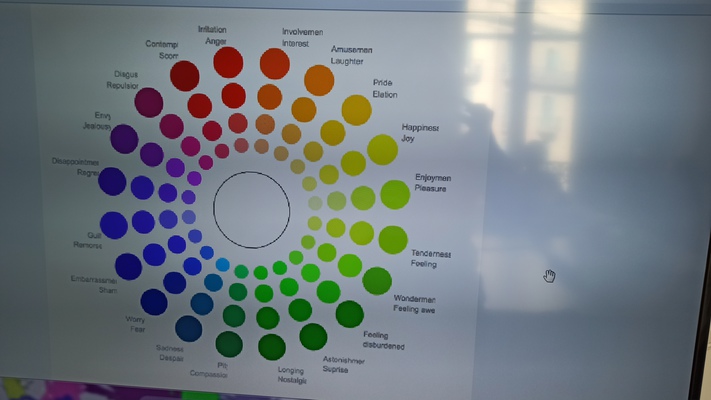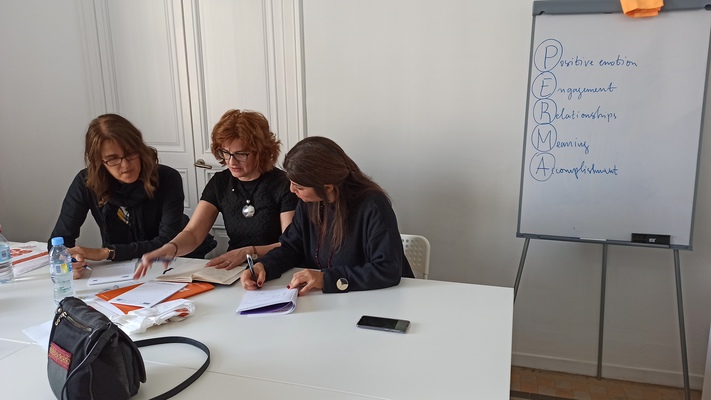Day 2 - 3th March 2020.
Drugi je radni dan započeo u 9,30 h s uvodnim predavanjem o pozitivnom podučavanju. Svatko od nas morao je iznijeti koje su njegove potrebe, a koji zahtjevi i zašto želi sudjelovati u ovom tečaju, a zatim u nekoliko riječi opisati sebe kao osobu. Nakon toga, SWAT analizom utvrdili smo svatko za sebe koje su naše snage i prilike, a koje slabosti i prijetnje. Sve što smo naveli za sebe već smo u razmišljanjima prenijeli na svoje učenike i osvijestili kako se osjećaju naši učenici u nastavnom procesu kada se suočavaju sa stresom. To je ono čime se bavi pozitivna psihologija, a njene teorije primjenjuju se u obrazovanju i zdravlju. Nama, učiteljima, itekako potrebna znanja kako bi svoje učenike što više motivirali za rad i stvorili pozitivno ozračje u razrednom odjelu.

Upoznali smo PERMA model - novu teoriju o tome kako se osjećati bolje, a time postići osjećaj sreće. Voditeljica Mila uputila nas je na autora dr. Seligmana i njegovu knjigu: Flourish. Novi je cilj pozitivne psihologije ne samo ljudska sreća, već i ljudski procvat.
Nadalje, upoznali smo se s teorijskim modelima o tri puta do postizanja sreće: ugodan život, dobar život i smislen život te kako kod svojih učenika postići misaoni rast koji je preduvjet za stvaranje pozitivnih emocija, razvijanje usredotočenosti i kreativnosti kod učenika. Istaknuti su primjeri kako je važno ne govoriti učeniku npr. da je pametan, već svojim osvrtima pratiti kod njega proces, trud i strategije u rješavanju problema. Naglasiti primjerice:"Našao si odličnu strategiju, pronašao si više načina u pristupu tom problemu".
Na taj način kod učenika razvijamo mudrost, znanje, hrabrost i kreativnost, a time raste motivacija za učenje.

Lijepa je misao toga dana bila da nema lijenih učenika već: drugačijih, nemotiviranih, umornih i s određenim poteškoćama, a mi te učenika pozitivnom pristupom možemo bolje razumjeti, a svojim podučavanjem kvalitetnije usmjeravati na stvaralački proces.
Na kraju smo radnog dana imali praktične aktivnosti: razne tehnike opuštanja koje u razrednom odjelu možemo primijeniti prije pisanih provjera, isticanje pozitivnog za svaki dan - što sam danas uspješno napravio? Jedna od vježbi bila je "Prizemljenje" koju koristimo kada učenici osjećaju uznemirenost ili neku drugu negativnu emociju. Vježba doprinosi osjećaju smirenosti iz koje tada proizlazi usredotočenost na aktivnost. Zadaci u vježbi su sljedeći: potrebno je promatrati oko sebe i pronaći te, u sebi, doživjeti, uočiti, zadržati se na trenutak na tom osjetu - 5 stvari koje možeš vidjeti, 4 stvari koje mogu dotaknuti, 3 stvari koje mogu čuti, 2 stvari koje mogu omirisati i jednu stvar koju mogu okusiti.
The second day began at 9.30 am with an introductory lecture on positive teaching. Each of us had to state their needs and requirements, why we wanted to participate in this course and describe themself in a few words. Then, by SWAT analysis, we identified what are our strengths and opportunities, and what are our weaknesses and threats. We have already conveyed everything that we have stated for ourselves in our reflections to our students and defined how our students feel in the teaching process when they are facing stress. This is what positive psychology is all about, and its theories are applied in education and health. This is for us teachers much-needed knowledge to motivate our students to work and create a positive atmosphere in the classroom.
We have come to know about the PERMA model - a new theory about how to feel better and thus achieve a sense of happiness. The host Mila directed us to the author dr. Seligman and his book: “Flourish”. The new goal of positive psychology is not only human happiness but also human flourishing.
Furthermore, we were introduced to theoretical models about the three paths to achieving happiness: a comfortable life, a good life and a meaningful life, as well as how to achieve the growth of thought that is a prerequisite for creating positive emotions, developing focus and creativity in students. Some examples highlighted the importance of not telling a student that he is e.g. smart, but instead to have remarks that follow his process, effort and strategies in solving the problem. To emphasize, for example, "You have found a great strategy, you have found more ways to approach this problem."
In this way, students develop wisdom, knowledge, courage and creativity, thus increasing the motivation to learn.
The nice message that day was that there were no lazy students but: different, unmotivated, tired and with certain difficulties, and we can better understand these students with a positive approach, and focus our teaching more on the creative process.
At the end of the day, we had hands-on activities: various relaxation techniques that we can apply in class before written exams, highlighting the positive for each day - what have I done successfully today? One of the exercises was the "Grounding" exercise that we use when students feel anxiety or some other negative emotion. Exercise adds to the sense of calm from which the focus on the activity then arises. The tasks in the exercise are as follows: it is necessary to look around and find in yourself, and then experience, notice and hold on to that feeling for a moment - 5 things you can see, 4 things you can touch, 3 things you can hear, 2 things you can smell and one thing you can taste.
.